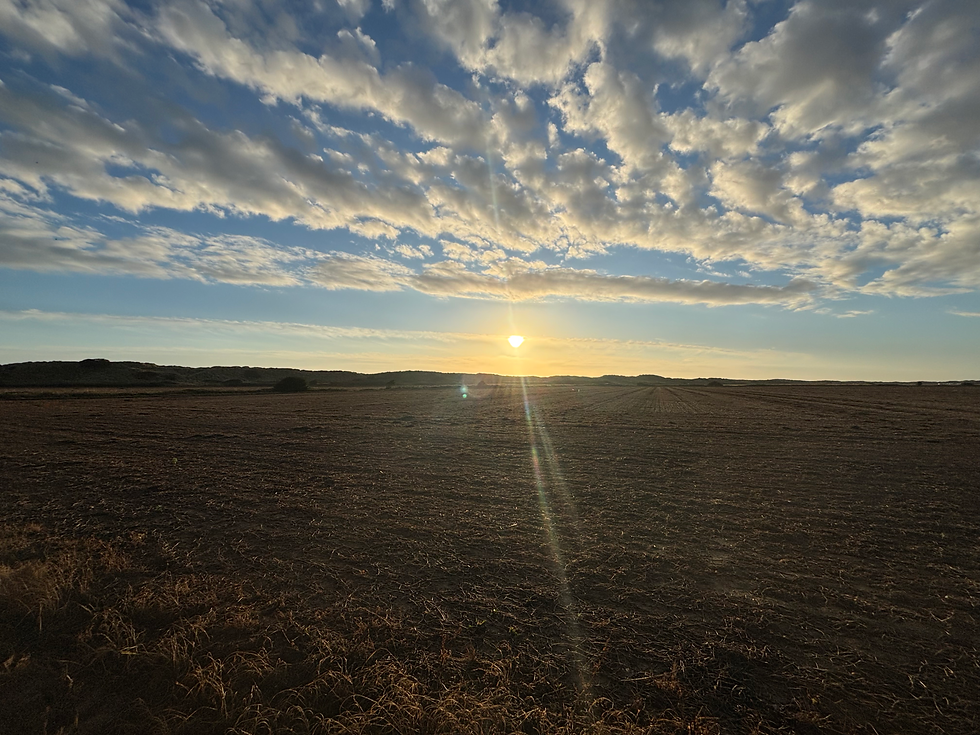A plexa Eastern Yellow Wagtail?
- tg42lowcarbonbirding
- Feb 22
- 4 min read
One Monday evening in Sept 2015, post-work, I decided to have a wander down to the pipe dump as my local spots around the village weren’t producing much. I walked across the field with the dog, but again, there wasn’t much activity. I entered the chicken farm field and after a few strides I put up a bird from very close by. As it lifted, it gave a raspy wagtail-like call and the immediate impression was of a very grey and white bird. I didn’t see where it went down so dug my phone out and called Andy Kane. “Just flushed what has to be a Citrine Wagtail”. I presumed all I had to do was refind it and it would be straightforward to sort out.
Two hours later I gave up in frustration and returned home deflated. I parked it in the box of ones that got away and moved on. Two evenings lagter, as I was going past the Priory, Ryan called and surprised me with an excited “Got a Citrine Wagtail at Waxham!). He wasn’t aware of my close encounter of the previous evening so to hear he’d got the same bird was fantastic. I called Andy to pass on the news and we both headed straight down, meeting Ryan in the large chicken farm field. The wagtail was very mobile and usually distant and loosely associating with a few Pied Wagtails and Meadow Pipits, which were occasionally flying around the field.
The wagtails and pipits were calling frequently as they flew and the sound of our bird was remarkably easy to pick out – a rasping buzzy call – tzreep, unlike and distinct from a typical Western Yellow Wagtail’s pseee or tseep. The call was heard several times over the next 45 or so minutes and flight views showed nothing other than a grey-and-white wagtail. However, seeing the bird on the ground was a different matter. The grass was long, and generally, as soon as the birds landed they were out of sight. Eventually, as the evening wore on, we managed to get a view as the bird came in to bathe briefly at a pool. Ryan fired off a couple of photos and I managed a bins view for a about 30 seconds. The bird looked essentially grey-and-white as we had presumed, with two clear wingbars – the greater covert bar being particularly well-marked, and a well-marked head pattern. We left for home confident that the bird was a Citrine.
Then things got more complicated. Viewing the two useful photos on a computer screen, rather than on the back of the camera in the field, something was amiss. There was a faint pale-yellow wash on the undertail of the bird and the median covert bar wasn’t quite as prominent as you’d like. There was also a dark line through the eye, across the upper edge of the ear coverts, and a dark edge to the upper supercilium. There was a decent whitish supercilium (contra thunbergi) and the throat and underparts were essentially white too, while the mantle was a darker shade than expected on a Citrine. Added together and with the call, this was essentially the same type of bird as the Eastern Yellow Wagtail at Eccles in 2013. Interestingly, I initially located that bird in driving rain by its explosive, buzzy, rasping call when flushed, but it too wasn’t seen until the next day when Andy heard it and then saw it, presuming as it landed that it was going to be a straightforward Citrine. Luckily, that bird stayed on farmland for several days allowing photos and close observation.


Given that the bird had moved on, the only thing I could think of, as very few people seemed interested in eastern-type Yellow Wagtails ten years ago – especially if they hadn’t seen the bird in question – was to contact Martin Garner. Martin had been extremely helpful and interested in our bird from 2013, confidently stating it was a “straightforward” Eastern Yellow Wagtail from our photos and call description.
This bird was a bit trickier as there were only two distant photos but from what was visible and the calls of the bird, he considered to be very likely an Eastern-type, presumably plexa rather than tschutschensis, which is perhaps what you’d expect given the Sep date of the bird. At the time, plexa was often considered to be eastern thunbergi (Grey-headed). It is now subsumed in tschutschensis as Eastern Yellow Wagtail.
It’s looking increasingly like Eastern Yellow Wagtails are not as rare as we once suspected, and are being turned up more regularly now. I am pretty sure that in the past a few Citrines have been accepted on call and perhaps some of these could have been Eastern Yellow Wagtails. So, don’t presume a grey-and-white buzzy autumn wagtail is a Citrine – you might be pleasantly surprised! Citrine Wagtail is one of the biggest omissions from the TG42 patch list so we’re desperately hoping than the next buzzy wagtail to visit us is an actual Citrine. And a spring bird hopefully!
A hat tip to the late Martin G. here, who did some fantastic work documenting these wagtails and was very helpful on both the occasions we asked for his advice on these eastern wagtails.
See also:
https://xeno-canto.org/ for examples of the calls of Eastern Yellow Wagtails and Citrine Wagtails




Comments